Back in 2015, countries around the world signed the 2030 Agenda on Sustainable Development and its 17 Sustainable Development Goals. The development of wind energy and renewable sources in Europe, in the last 10 years, has been rather uncertain and stagnant.
Also, in the same year, more than 70 countries signed the Paris Agreement and mentioned wind energy in their Intended Nationally Determined Contributions (INDC) as a key mitigation measure against climate change, according to Wind Europe.
Given their plan, the European Commission is calling on the renewable energy industry to deliver 480 GW of wind capacity by 2030 to improve Europe's security of energy supply.
Four of the countries that signed the Paris Agreement are Germany, Czech Republic, Romania and Slovakia. We looked at their national strategies regarding renewable energy, more precisely wind energy, and tried to compare the data we have been able to find and see if we can find some similarities. Also, trying to see what the main differences are.
Germany has a very ambitious Plan to meet the EU Climate Standards. The Government wants to decarbonize the Country, so that the Carbon output is 55% less than in 1990. Which includes the coal-fired power generators that they want to turn off in 2038, at the latest.
Now, German Onshore Wind turbines produce almost 60,000 Megawatt (MW) or 6 Gigawatt (GW) of Energy. That's 40% of all Energy in Germany. So, in the next 8 years, the output has to be doubled since Germany wants that 80% of all energy to come from renewable sources by 2030. This is what the national renewable energy law is regulating.
Here we have a chart of existing wind turbines on land. It shows that Germany has 28.230 wind turbines right now.
https://www.canva.com/design/DAFNncOpRCs/gbfkRdsYu3yKym69P0BcmA/edit?utm...
Existing Wind Turbines(on land)
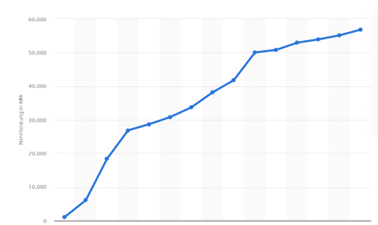
The Output of German Windturbines
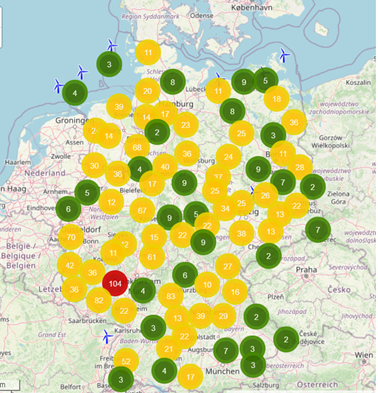
Map of Windparks in Germany
There aren't as many Offshore Windparks as there are onshore, but the Number of Turbines in the sea has increased as well in recent years.
What are their plans?
Germany wants that by 2026, 1.4% of the National Area to be covered with Wind Turbines, and that should ramp up to 2% in 2032.
The only problem that could appear is that there has to be a minimum distance between Wind Turbines and living areas, usually at least 1 km, and also the fact that they cannot be built near protected areas, such as parks, national parks, industrial areas and bio-reservations.
The plan is to reduce the primary energy consumption of Germany by 30% compared to 1990. That covers consumption of the energy sector itself, losses during transformation (for example from oil or gas into electricity) and distribution of energy, as well as the final consumption by end users.
Yet, despite all of that, the German government also wants to have a secure net of energy, to be able to cover Germany's demands at all times.
And all of that can be done with the Renewable-Energy Sources-Act. This law states that 80% of ALL energy in 2030 has to be produced by renewable Energies.
The idea of that has existed longer than the Law itself. Wind energy has been big for a long time, and has only been growing bigger.
From about 11,000 wind turbines in 2001 it grew to over 28,000 in 2021. But since 2017, the expansion has slowed down. While almost 1800 Turbines had been built in 2017 in the following years the average of newly built turbines had been about 500. In 2021, 484 new turbines were built. The number went down from 29,600 to 28,200 though, because many inefficient old turbines had been taken down.
Still, the Energy Output has continuously risen throughout the years.
Yet, there are Problems as well. The amount of rules and bureaucracy that has to be overcome in Germany to just build a single wind turbine is ridiculous. All in all, it takes about 7 years in average to build just one, explains Felix Losada from the Turbine producer Nordex.
Reasons for that are a missing digitalization, and then the requests from the companies get lost in the German Jungle of Bureaucracy. Additionally, Cities and Small Towns often don't want these Turbines close to their living area, so they protest as well.
These are just some of the Problems that exist. Others are various discussions about how height and distance from towns correlate, or the Tabuzones near Protected areas, national Parks and Industrial Areas. Additionally there is a certain unwillingness of the Bundesländer to actually do something.This unwillingness of the Bundesländer goes so far that even the Vice-Chancellor and Minister for Climate Protection Robert Habeck has publicly reprimanded them.
“We can pass as many laws as we want, but if you don't do your part in this, then that doesn't matter. So please, Bundesländer, do your job” he said at the opening Ceremony of the WindEnergy Exposition in Hamburg.
Czech are supporting renewable energy but not on their backyard
Building a small private reusable energy power plant in Czech Republic is now easier. People do not need a license or building permit for plants up to 50 kW. Czech government approved this September the amendment in order to become more energy independent.
“We want to support the use of renewable energy sources and reduce energy dependence on Russia”, says Czech minister of industry and trade Josef Síkela.
Renewable energy sources make only around seven percent of the energy made in Czech Republic. One percent is made by wind turbines.
Scientists from Czech Academy of Science say that the number could increase 25 times up to in 2040 They published this data in a study as an optimistic scenario. Also came up with a pessimistic scenario, which still counts with building four times more turbines than they are now.
The Czech Wind Energy Association, using the same data, says that wind could make from 10 up to 31 % of Czech energy mix in 2040. Text is comparing data with 2019 electricity consumption. The percentage could be different in twenty years.
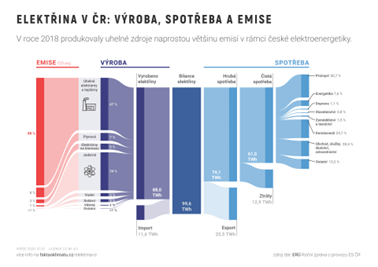 Source: Faktaoklimatu.cz
Source: Faktaoklimatu.cz
Current Czech energy mix, renewable energy sources make seven percent made energy, 47 percent are made by coal plants, which are also responsible for 88 percent of energy-made emissions.
Wind energy is also a part of the national strategy to adapt for climate change made by the Ministry of the Environment in 2015 and actualised in 2020 and other governmental documents.
But none of them include data and direct plans to implement wind turbines to Czech energy mix. Only data for Czechia are published by the European Parliament and say that wind energy would increase three times between 2016 and 2030. The government does not support renewable energy much. That could change related to the current energy crisis.
Potencial of the wind energy in Czech Republic is great, thanks to its countryside. Suitable conditions for wind turbines are especially in the Vysočina region, which is an agriculture region with hilly landscape. Now, there are only three plants there.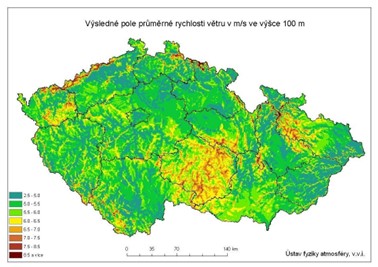 Wind map of Czech Republic, Source: The Czech Wind Energy Association
Wind map of Czech Republic, Source: The Czech Wind Energy Association
Similar situation is with the South Moravian region. Its neighbor, the Austrian Lower Austria region, is a source for more than half of the wind energy made in this state.
To accomplish the European aim to become carbon neutral till 2050, Czechs should implement renewable energy sources. They could inspire themself in neighboring states such as Germany or Austria. What can also motivate to heighten using wind and renewable energy, is public opinion on this topic.
“The public clearly favors renewable energy sources over other sources,” write Tomáš Habada and Jan Krajhanzl, researchers and environmentalists from Masaryk University in their study published in 2020.
On the other hand, researchers and journalists also witness reluctance for building wind turbines. Server O energetice (About Energy) this summer wrote an article about resistance of inhabitants in north Bohemia village, where a private company wants to build the biggest wind power plant in Czech Republic. According to the article, people are scared of noise caused by turbines.
Companies should communicate more transparently, so should the government. The new law could open a door for building more renewable energy sources. This is one of the problems that we identified in Romania too. The government delays the procedures of building new turbines and also their communication is done poorly.
The Black Sea, wind and Romania’s plans on renewable energy sources
Surprisingly, Romania has grown a lot when it comes to wind energy and its capacities. A lot, but still has more to go. At the end of 2010, Romania had less than 20 MW of wind energy installed. However, at the start of 2011, more projects were developed and so in total there were 550 MW installed, according to DW.
Talking about wind farms, Romania has 59 and 1500 wind turbines. The Fântânele-Cogealac Wind Farm was completed in 2012 and at that time was the largest in Europe. Also, the Dobrogea region, which consists of Constanța and Tulcea counties, has the second highest wind potential in Europe.
Currently, the country has about 3 GW which covers about 10% of electricity consumption.
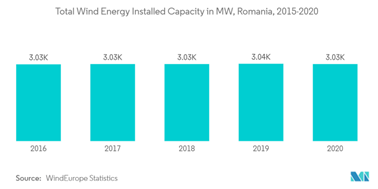 Source: Mordor Intelligence Website
Source: Mordor Intelligence Website
”In 2020, Romanian power company Hidroelectrica announced plans to build 600 MW of wind power capacity by 2026, including a 300 MW onshore and 300 MW offshore wind farm that would be the first-ever to be built in the Black Sea”, according to Mordor Intelligence.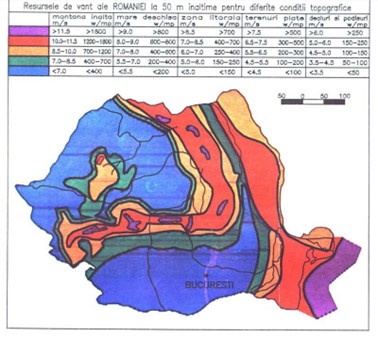 Wind resources in Romania, purple shows where is the highest energy (measured in KW)
Wind resources in Romania, purple shows where is the highest energy (measured in KW)
And right now, with Europe facing an energy crisis on multiple levels, we have heard a lot about renewable energy and EU’s plans and regulations and I guess everyone has observed how important these two are. But we are trying to see how all of this is actually translated into reality.
Romania’s share of energy from renewable sources set for 2030 has gone up from 27.9% to 30% in 2020, but it is still below the 34% renewable share resulting from the formula in Annex II to the Governance Regulation, according to the Commission's feedback.
Even though some countries have doubled their wind capacity in the last years and even though climate change, Covid and the war in Ukraine has shown us how important renewable energy sources are, Romania is still not doing so great at this chapter.
National regulations
To fight climate change, the president of Romania, Klaus Iohannis, has established a work group called ”Fighting climate change: an integrated approach”. All their decisions should have been made public but until now nothing has been shown in this particular direction.
But earlier this past September, the president published a report on climate change. There are several parts where wind energy is mentioned briefly and what are their plans, plus how they want to use all of the resources that Romania has.
They mentioned trying to educate people in schools about climate change. ”Educated Romania” is the national project initiated by the President of Romania. Even though the official site of the project says it is ”the largest and longest-running public consultation on public policy in education to date”, it received a lot of criticism from the press and from people in Romania because of how long it has been delayed.
Another important aspect is that Romania can benefit from energy onshore and offshore. The last one has more important wind resources that can be exploited during winter time. Also, when we talk about onshore energy, that can also reach a saturation point so the coastal and marine regions could help with this, said the authors of the scientific paper ”Assessment of the Romanian onshore and offshore wind energy potential”.
2020 was a bad year for Romania’s offshore energy. The main reason is because Exxon Mobil announced its intention to sell their 50% share in the Neptun Depp offshore project on Romania’s Black Sea. And a buyer has yet to be found, according to an article published on Energy Europe’s website.
What comes first: climate neutrality or companies safety?
A main obstacle, in benefiting from the offshore energy in Romania, is the legislation. Back in 2018, a previous center-left government, has adopted a prohibitive legislation concerning any foreign involvement in gas exports. So, it all comes down to money.
”Since the current total output of Romanian gas fields does not cover domestic demand (output stands at around 90% of demand), the legislation means an effective ban on gas exports. If foreign companies do participate in Romanian gas projects, they must pay an excessive tax”, said the article from Energy Europe.
That is not attractive for foreign companies. Also, add to that the strict European standards and costly equipment and you can see why this is not being exploited, developed or used more. Anyhow, the government mostly thinks about this resource as a financial one, not taking into consideration the objective of climate neutrality.
Another problem is that this big tax makes it impossible for companies to use renewable energy.Romania’s wind energy minister, Virgil Popescu, has assured everyone that this tax will soon be lifted. Actually, the offshore law has been sent to the Chamber of Deputies and it remains to be seen. The new law promises lower taxes and freedom for companies to sell gas anywhere.
However, the lifting of the tax does not come with a procedure on how to protect the climate. Mostly, it is concerned with financial issues.
Romania can definitely benefit from renewable energy that comes from offshore and onshore energy but that has to come before the big company's interests. Also, the legislation should take into consideration the climate issue and the government should try and see how they can hurry the procedures. For instance, the controversy of the offshore law has been going on for four years already and even now the political class does not seem interested in solving the problems.
Nine wind turbines have been built in Slovakia. They produce a negligible amount of electricity and more than technological facilities, they are showplaces for tourists.
Only two of them are currently working. Although, building of new ones are being considered because of National Energetic and Climatic strategy, which estimates ca. 600 MW made by using wind. Many potential investors are discouraged by environmental impact assessment, which is inappropriately complicated and bureaucratic.
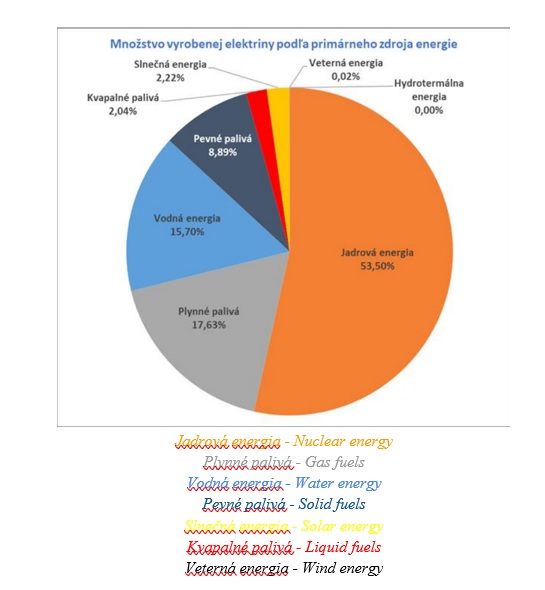 Hydrotermálna energia - Hydrothermal energy
Hydrotermálna energia - Hydrothermal energy
The amount of electricity produced according to the energy source (OKTE, a.s.)
The first turbine park built in Slovakia is located in western part of the country, in the village of Cerová. One morning in February this year, the blade of one turbine made in 2003 dropped out. After the 70 meters flight, it ended up in a nearby park, harming nobody.
Since then, another two turbines in the park are out of service after the technical check. Only one of them is working now. The rest of the turbines in Slovakia are shut down, except for one in the region of Myjava.
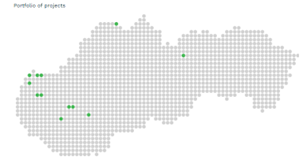
Map shows windparks, both planned but unrealised and working ones.
More than 53% of the electric energy made in Slovakia is being generated by NPP's. Moreover, the brand new 3rd unit of NPP Mochovce will be launched until January 2023. After that, the country will become self-sufficient in production of electricity.
In 2021, Slovakia needed to get 727 GWh from abroad, especially Czech Republic and Poland, says the national producer of energy (Slovenské elektrárne).
Also, the 4th unit is in construction. Completion of Mochovce will make Slovaks able to end coal mining and generate electricity out of it. The government stops subsidizing coal mining by the end of 2022.
Slovakia as a Hydrogen leader?
As a member of The European Union, Slovakia has to reach an emission goal (55% less than in 1990) by 2030. According to the National Hydrogen Using Strategy, Hydrogen would be covering 24% of world electricity usage.
The Slovak Ministry of Economy wants to donate hydrogen startups and also use Hydrogen as a fuel in transportation, for example trains. According to the National Hydrogen Strategy, Slovakia should produce 45,000 tons of "clean" Hydrogen in 2030 and use it as a fuel in transportation and industry.
But the progress is a bit questionable because the minister of economy, Richard Sulík, supporter of hydrogen startups and technologies, had to resign due to a government crisis.
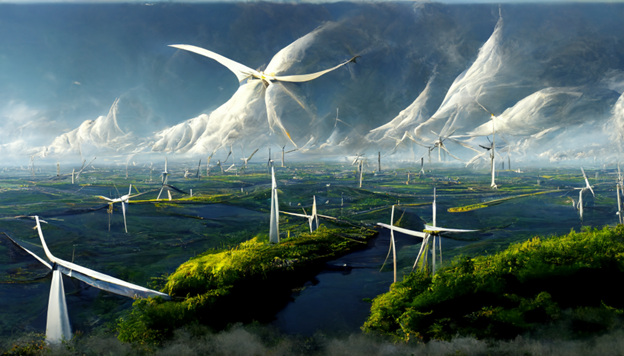 Turbines for homes? Not yet…
Turbines for homes? Not yet…In accordance with the Environmental Quality Operational Program, the installation of small wind turbines intended for the production of electricity can also be supported as part of the Green Homes projects. However, the actual use of these facilities in Slovakia is currently hindered by several obstacles. Due to the need to amend generally binding legal regulations, it is not yet possible to issue vouchers for the installation of wind turbines.
Given all the data that we have collected, it shows that the problems standing in the way of using wind turbines to fight climate change are related to bureaucratic reasons and lack of transparency from the governments.
Also, Germany and Czech Republic have more wind turbines and seem to have a more complex strategy on how to tackle the problem, while Romania and Slovakia plans are rather uncertain. The last years have been stagnant for wind energy programmes and the countries should start coming up with more solutions.
But until they do so, we thought of asking an AI about the future and see if it has any answers. We wrote a prompt, and it imagined a green future with lots of wind turbines so… let’s say this picture gave us a silver lining (Image made with MidJourney Software).
Authors: Martin Guniš, Nick Gehrmann, Andra Maria Mureșan, Jakub Radan Dvořák